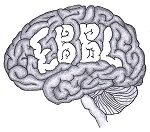“How are you feeling?”
“Horny.”
Not exactly an interaction one expects to find in a neuroscience blog, is it? But, prudish social norms aside, sexuality is a very normal part of human life, with the same psychological, biological, and neurological pathways of explaining and exploring it. Despite what college culture would like you to believe, sex is a highly emotional subject and experience, in that it evokes and is influenced by emotional processes. This blog therefore looks to explore sexuality from various perspectives, with an emphasis on the role of emotion. On this first post, I explore how emotions and sexual arousal interact.
But– what is sexual arousal? What does it mean to “feel horny”? And what does this have to do with emotion?
Sexual arousal, or being “turned on,” can be defined as the combination of cognitive and physical responses to an erotic stimulus, which in turn can be internal or external. One can feel aroused by appraising a picture, touching and being touched, or by one’s own thoughts or fantasies. Arousal includes physiological activation, such as increased blood flow to the genitals, erection of nipples, vaginal lubrication, swelling of the testes, and pupil dilation. It also includes a subjective appraisal of feeling sexually aroused, what we mentioned earlier as the subjective experience of “feeling turned on.” For all these things to happen, something needs to go down in the brain.
Many studies have looked at what happens in the brain during sexual arousal, usually observed in the context of subjects responding to visual erotic stimuli, colloquially termed “sexy or dirty pictures.” This has produced a long list of structures and areas both in the more sophisticated cortex and primitive sub-cortical structures found to be implicated. The former include the superior and inferior parietal lobes, the lateral occipital cortex, the medial prefrontal cortex, the anterior cingulate cortex, and the insula. Implicated subcortical areas are the ventral and dorsal striatum, the amygdala, and the hypothalamus (Mouras et Stoléru 2005).
Of course, these brain regions are also responsible for many, many other mechanisms, and that’s where the caveat lies. Sexual arousal, or anything in the human experience for that matter, doesn’t happen in a vacuum, but rather in a context, with all those contextual variables also being processed– which is where emotion comes in. Because sexual arousal is recognized to have a strong emotional component, one group of scientists (Walter et al., 2008) designed an experiment to specifically disentangle brain activation due to the sexual activation response to a stimulus, versus the general emotional arousal either produces. Their analysis found that, out of all the brain regions cited above, only the hypothalamus and ventral striatum (VS) were independently involved in specific sexual processing, with the peri-genual Anterior Cingulate Cortex (pgACC) playing a modulatory role between affect and sexual arousal. This means that the activation in all the other regions was due to other types of processing, including that of general emotional arousal. The key point to take out of this study is not that the other studies were lying to us and that those other brain regions have nothing to do with sexual arousal, but the realization that life is no lab experiment and that in it all those brain regions are activated and involved in sexual arousal because all those other things, such as body recognition, pleasure, and emotion are part of the experience being sexually aroused.
This is particularly evident when one examines the concrete ways in which affect influences sexual arousal responses. As one would expect, studies have found that when people are primed to be in a good mood, they experience higher subjective and physiological sexual arousal (Koukounas and McCabe, 2001)). Studies on negative affect have been more mixed. However, these findings have important real-world consequences, such as informing treatment for individuals with sexual dysfunctions. For example, while it was assumed that negative affect played a central role in sexual disfunction, new research evidences that perhaps it is the absence of positive affect that produces dysfunction (Peterson & Janssen, 2007). This would explain why diminished sexual response is common in depression, a condition characterized by low positive affect, than in anxiety, which is a condition of high negative arousal. In fact, anxiety has been shown to facilitate sexual arousal, presumably because as a state of high physical arousal, it exacerbates sexual arousal. At the same time, studies have shown how sexual arousal influence affect, such as by diminishing stress levels (Hamilton et al., 2008).
So, what did we learn? That feeling “turned on” implies a variety of cognitive, physiological, and neurological processes, which include and are influenced by emotion.
References:
Hamilton, L. D., Rellini, A. H., & Meston, C. M. (2008). Cortisol, sexual arousal, and affect in response to sexual stimuli. The journal of sexual medicine, 5(9), 2111-2118.
Koukounas, E., & McCabe, M. P. (2001). Sexual and emotional variables influencing sexual responses to erotica: A psychophysiological investigation. Archives of Sexual Behavior, 30, 393–408.
Mouras, H., & Stoléru, S. (2005). Functional neuroanatomy of sexual arousal. Male sexual dysfunction: Pathophysiology and treatment.
Peterson, Z. D., & Janssen, E. (2007). Ambivalent affect and sexual response: The impact of co-occurring positive and negative emotions on subjective and physiological sexual responses to erotic stimuli. Archives of Sexual Behavior, 36(6), 793-807.
Walter, M., Bermpohl, F., Mouras, H., Schiltz, K., Tempelmann, C., Rotte, M., … & Northoff, G. (2008). Distinguishing specific sexual and general emotional effects in fMRI—Subcortical and cortical arousal during erotic picture viewing. Neuroimage, 40(4), 1482-1494.

I like your point about how sexual arousal has emotional and non-emotional components and that this is potentially important in terms of understanding the processes that are carried out in the brain regions that are implicated.